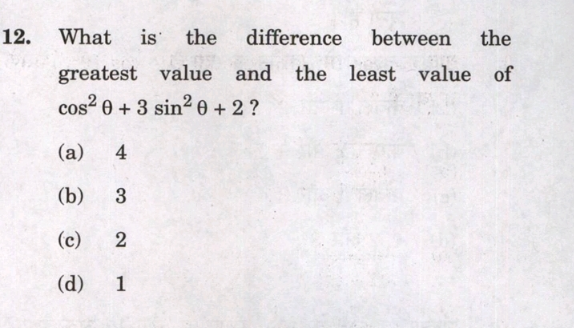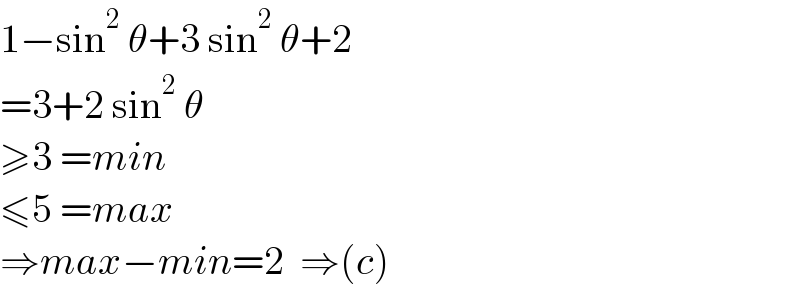
Question Number 206912 by BaliramKumar last updated on 30/Apr/24

Answered by A5T last updated on 30/Apr/24

$${cos}^{\mathrm{2}} \theta+\mathrm{3}\left(\mathrm{1}−{cos}^{\mathrm{2}} \theta\right)+\mathrm{2}=\mathrm{5}−\mathrm{2}{cos}^{\mathrm{2}} \theta \\ $$$$\Rightarrow{Max}=\mathrm{5}−\mathrm{0};\:{Min}=\mathrm{5}−\mathrm{2}\Rightarrow{Difference}=\mathrm{2} \\ $$
Answered by mr W last updated on 30/Apr/24

$$\mathrm{1}−\mathrm{sin}^{\mathrm{2}} \:\theta+\mathrm{3}\:\mathrm{sin}^{\mathrm{2}} \:\theta+\mathrm{2} \\ $$$$=\mathrm{3}+\mathrm{2}\:\mathrm{sin}^{\mathrm{2}} \:\theta \\ $$$$\geqslant\mathrm{3}\:={min} \\ $$$$\leqslant\mathrm{5}\:={max} \\ $$$$\Rightarrow{max}−{min}=\mathrm{2}\:\:\Rightarrow\left({c}\right) \\ $$
Answered by MM42 last updated on 30/Apr/24

$$\frac{\mathrm{1}+{cos}\mathrm{2}\theta}{\mathrm{2}}+\mathrm{3}\frac{\mathrm{1}−{cos}\mathrm{2}\theta}{\mathrm{2}}+\mathrm{2} \\ $$$$=\mathrm{4}−{cos}\mathrm{2}\theta \\ $$$$\Rightarrow{M}=\mathrm{5}\:\:\&\:\:{m}=\mathrm{3}\Rightarrow{M}−{m}=\mathrm{2}\:\:\checkmark \\ $$$$ \\ $$
